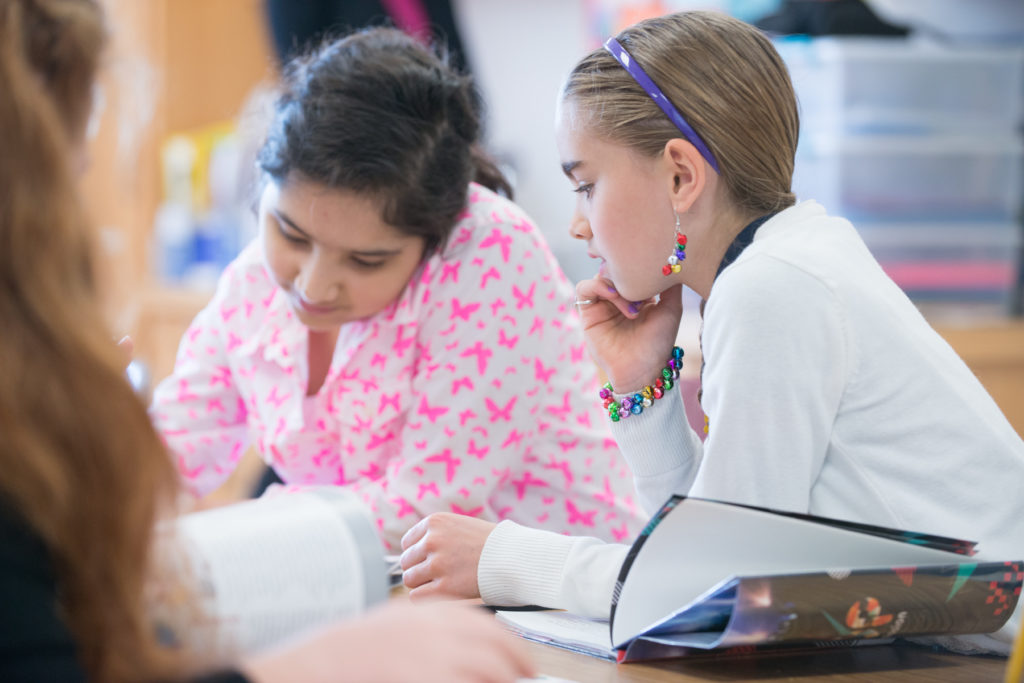
Fifth grade teacher Ms. Johnson begins class by naming the lesson goal: to write an essay that includes the fundamental elements of persuasion. She displays criteria for good work on the whiteboard and gives each student a checklist of grade-appropriate elements of persuasive writing. She then asks students to take a moment and think of their personal goal for this essay and to record that goal in their writing journal.
Soon, students are busy writing their essays, referring to the checklist often as they work. Ms. Johnson circulates, observing and checking in with students.
At the end of the writing period, Ms. Johnson projects onto the board a persuasive writing rubric. She asks students to compare their draft to the criteria on the rubric. After they’ve had time to reflect, Ms. Johnson asks, “What is one piece of your draft that you think meets a level three or four? What is one thing you’d like to work on in revision? Take a minute and think and then make a note in your journal.”
In school, the word “assessment” is often linked to testing, grading, and ranking. But, as shown in Ms. Johnson’s class, self-assessment is also tied to goal-setting, which begins with students realistically assessing where they are and then deciding on a meaningful and realistic goal they want to reach. And that’s a skill students can use throughout their lives.
When built into daily schoolwork, goal-focused self-assessment fosters academic achievement by helping students:
Many teachers who use the Responsive Classroom approach begin the year by asking students to articulate hopes and dreams (or broad goals) for the year’s learning. Taking the time to reflect with students on broad learning goals opens the year with a message of possibility and growth. It also sets a tone that helps them feel invested in setting and working to achieve specific learning goals throughout the year.
Goal-setting and self-assessment should be an ongoing process. Although you will set lesson-by-lesson goals, often in accordance with district or state standards, students can have a voice in setting their own learning goals.
This process reflects the natural learning cycle of generating ideas and goals; actively exploring, experimenting, and problem-solving; and reflecting on experiences.
The self-assessment opportunities you structure throughout a lesson can help students answer the question: “Is the work I’m doing helping me reach my learning goal?” One self-assessment tool you can use is a checklist. A checklist spells out what needs to be included in a piece of work. You might list, for example, the key elements of a fictional story, a plan for a science experiment, or the components of a commercial jingle. The students in Ms. Johnson’s fifth grade class referred to the following checklist to make sure they were including key elements of persuasive writing in their essays:
Checklists serve as useful reminders of specific expectations and can help students stay focused and on task when working independently on assignments. Students can only be reminded of what they already know, so be sure your checklists contain items that you’ve already introduced to them.
Through self-assessment, students begin to recognize for themselves what they don’t know, and what they want to know. They become aware of their own strengths and challenges and are more familiar with their beliefs and misconceptions. And when students know themselves better, their learning deepens. They’re apt to set higher goals for themselves, become more self-motivated, and demonstrate more perseverance toward reaching their goals. In other words, they become engaged learners.
Whether simple or complex, self-assessment helps students monitor and evaluate their own work and identify ways to improve their learning. The Joyful Classroom offers a variety of self-assessment tools and strategies students can use as aids in meeting their learning goals. You’ll also learn about:
With each strategy, you’ll find suggestions for implementation, examples from classrooms, and lesson ideas to help you make students’ learning active, interactive, relevant, and exciting. Try these strategies and watch your classroom become one where the light of learning burns brightly for every student.
Learn more about helping students develop a growth mindset in: